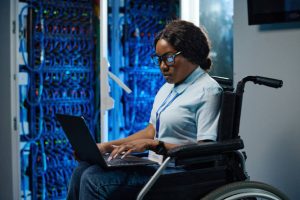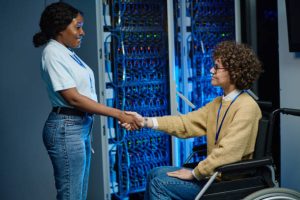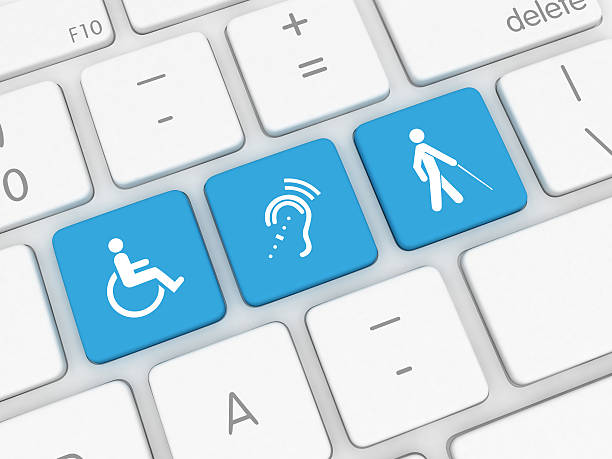Whilst browsing the internet, I stumbled upon two photos. The first photo showcased a woman wearing glasses and sitting in a wheelchair while using a laptop. I had planned to use this free stock photo for an article I was working on. It perfectly matched the theme and highlighted the involvement of people with disabilities and women in the digital space.

African female IT engineer with a disability sitting in a wheelchair and typing on a laptop in a data centre
However, as I continued scrolling, I came across the second photo. This photo featured two individuals. The first person was the lady from the previous picture was now pictured standing on her feet, extending her hand to the second lady seated in a wheelchair. Unless she has an identical twin, it seemed that the lady in the first photo had miraculously healed from her disability.

African IT engineer standing and shaking hands with server worker in wheelchair during their work in data center
My concern is not about how she got up on her feet, as I understand that it was created for stock media. They might have had good intentions of representing people with disabilities, perhaps intending to promote inclusivity. They did well in that aspect. However, the issue lies in representing disability. Disability is not a performance and should not be treated like one.
Your experience sitting in a wheelchair for a couple of hours or for a photo op would not compare even to the tiniest of the experiences that a person with a disability who is a wheelchair user goes through. Blindfolding yourself to walk around the room cannot be a representation of what the blind go through in their daily life. Your feedback from playing disability will be skewed. Psychologically you know that this is just an act. Your brain is aware that in a couple of minutes, you won’t be experiencing the same.
According to the United Nations Department of Economic and Social Affairs, people with disabilities are often misrepresented and underrepresented when they are not involved in providing information about their own experiences. Making assumptions about how someone with a disability might feel in a hypothetical situation is not the same as understanding their actual lived experiences.
Even within the realm of disabilities, it is impossible for one person to fully comprehend the experiences and challenges of another individual with a disability. Disability is multifaceted and diverse. For example, a deaf person cannot accurately describe the experiences of someone with a physical disability, and someone with Down Syndrome cannot fully represent the lived experiences of a blind person.
In recent years, the collection of data for training Artificial Intelligence (AI) models has increased significantly. However, there is a lack of information on individuals with disabilities, which perpetuates a narrow definition of “normal” by excluding them from the data. This trend could lead to further marginalization of people with disabilities in the implementation of these technologies. It is crucial that AI models have information on this group to ensure equal performance for all users. Failure to do so could result in inadequate performance for those with disabilities.
Individuals with disabilities must be allowed to speak for themselves and have their voices heard. The only way to achieve this is by actively involving them in decision-making processes such as creating policies, laws and guidelines, and making sure they are fully included. Collaborating with individuals with disabilities is the cornerstone of creating an inclusive environment.
Nicodemus Nyakundi is an ICT Access and Equality Fellow for PWDs at KICTANet. He has a background in IT and advocates for digital inclusivity.
![]()





Good information especially for trainers dealing with trainees with physical disabilities. However, we need more sensitization on this in the TVET institutions.
Thank you, Jennifer. I completely agree that it would be beneficial to have discussions about this topic in TVET institutions. The current lack of accessibility, assistive technology, and inclusive training models has discouraged individuals with disabilities from pursuing STEM courses and training.